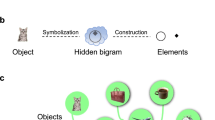Abstract
We present the results of an ongoing research in the area of symbol grounding. We develop a biologically inspired model for grounding the spatial terms that employs separate visual what and where subsystems that are integrated with the symbolic linguistic subsystem in the simplified neural model. The model grounds color, shape and spatial relations of two objects in 2D space. The images with two objects are presented to an artificial retina and five-word sentences describing them (e.g. “Red box above green circle”) with phonological encoding serve as auditory inputs. The integrating multimodal module is implemented by Self-Organizing Map or Neural Gas algorithms in the second layer. We found out that using NG leads to better performance especially in case of the scenes with higher complexity, and current simulations also reveal that splitting the visual information and simplifying the objects to rectangular monochromatic boxes facilitates the performance of the where system and hence the overall functionality of the model.
Access this chapter
Tax calculation will be finalised at checkout
Purchases are for personal use only
Preview
Unable to display preview. Download preview PDF.
Similar content being viewed by others
References
Harnad, S.: The Symbol Grounding Problem. Physica D 42, 335–346 (1990)
Barsalou, L.: Perceptual symbol systems. Behavioral and Brain Sciences 22(4), 577–660 (1999)
Riga, T., Cangelosi, A., Greco, A.: Symbol grounding transfer with hybrid self-organizing/supervised neural networks. In: Int. Joint Conf. on Neural Networks (2004)
Millner, A., Goodale, M.: The Visual Brain in Action. Oxford University Press (1995)
Vavrečka, M., Farkaš, I.: Unsupervised grounding of spatial relations. In: Proceedings of European Conference on Cognitive Science, Sofia, Bulgaria (2011)
Kohonen, T.: Self-Organizing Map (3rd, extended edition). Springer, New York (2011)
Stein, B., Meredith, M.: Merging of the Senses. MIT Press, Cambridge
Martinetz, T., Schulten, K.: A neural-gas network learns topologies. In: Kohonen, T., et al. (eds.) Int. Conf. on Artificial Neural Networks, pp. 397–402. North-Holland, Amsterdam (1991)
Li, P., McWhinney, B.: PatPho: A phonological pattern generator for neural networks. Behavior Research Methods, Instruments and Computers 34(3), 408–415 (2002)
Voegtlin, T.: Recursive self-organizing maps. Neural Networks 15(8-9), 979–991 (2002)
Author information
Authors and Affiliations
Editor information
Editors and Affiliations
Rights and permissions
Copyright information
© 2011 Springer-Verlag Berlin Heidelberg
About this paper
Cite this paper
Vavrečka, M., Farkaš, I., Lhotská, L. (2011). Bio-inspired Model of Spatial Cognition. In: Lu, BL., Zhang, L., Kwok, J. (eds) Neural Information Processing. ICONIP 2011. Lecture Notes in Computer Science, vol 7062. Springer, Berlin, Heidelberg. https://doi.org/10.1007/978-3-642-24955-6_53
Download citation
DOI: https://doi.org/10.1007/978-3-642-24955-6_53
Publisher Name: Springer, Berlin, Heidelberg
Print ISBN: 978-3-642-24954-9
Online ISBN: 978-3-642-24955-6
eBook Packages: Computer ScienceComputer Science (R0)




